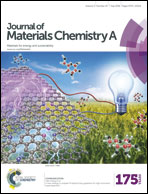Top-down dispersion meets bottom-up synthesis: merging ultranano silicon and graphene nanosheets for superior hybrid anodes for lithium-ion batteries†
Abstract
A breakthrough Si ultranano particle (SiUP, size d ≤ 10 nm) inserted nitrogen-doped graphene nanosheet (SiUP@N-GNS) is designed as an anodic material for lithium-ion batteries. In this contribution, a continuous manufacturing process, including top-down dispersion followed by bottom-up synthesis, is addressed incorporated with facile and cost-effective strategies to realize industrial feasibility. Within this specially designed architecture, the volumetric variation induced by high capacitive SiUPs during lithiation/delithiation processes is mitigated effectively by means of several strain-released functions to extend the cycling lifetime. The intrinsic properties, including particle size, compositional configuration, and the spatial distribution demonstrated by SiUPs will alleviate the drastic volume change and local expansion within the nanostructure during cycling. Furthermore, in addition to establishing conductive networks, extended 2D-folded N-GNSs enclosed with SiUP nanoclusters provide mechanical supports to buffer structural variations and to further stabilize active electrodes. As a leading high capacity graphene-based anode material, this state-of-the-art design exhibits long cycling performance up to 600 cycles at a current density of 0.5 A g−1 with the initial specific capacity higher than 1200 mA h g−1 and a low capacity fading of less than ca. 0.09% per cycle.


 Please wait while we load your content...
Please wait while we load your content...